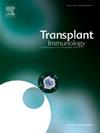The regulatory mechanism of long non-coding RNAs (lncRNAs) of integrin alpha L (ITGAL) sequences (lncRNA-ITGAL) in CD4+ T cell differentiation during immune rejection of corneal transplants
IF 1.6
4区 医学
Q4 IMMUNOLOGY
引用次数: 0
Abstract
Objective
Corneal blindness remains a major global contributor to visual impairment, affecting approximately 6.17 million individuals. High-risk corneal transplantation is associated with rejection rates of up to 50 %, necessitating the development of new therapeutic strategies to complement or enhance conventional immunosuppressive treatments, including corticosteroids and calcineurin inhibitors. This study aimed to examine the regulatory function of long non-coding RNAs (lncRNAs) transcribed from integrin alpha L (ITGAL) sequences (lncRNA-ITGAL) in CD4+ T cell differentiation during immune rejection following corneal transplantation.
Methods
Sprague Dawley rats (n = 20) were assigned to either a control or rejection group. Corneal rejection indices were assessed two weeks post-transplantation. Histopathological evaluation was performed using hematoxylin and eosin staining. RNA sequencing was conducted to analyze differentially expressed lncRNA and messenger RNA profiles. Flow cytometry was used to quantify Th1, Th2, and Th17 subsets in human peripheral blood mononuclear cells. Quantitative reverse transcription polymerase chain reaction was employed to measure the expression of lncRNA-ITGAL, miR-378a-3p, and tumor necrosis factor receptor-associated factor 1. Spatial interactions were examined through fluorescence in situ hybridization and immunohistochemistry.
Results
Corneal tissues in the rejection group exhibited significant stromal edema and opacity (p < 0.05). RNA sequencing identified 7057 differentially expressed lncRNAs and 5485 differentially expressed mRNAs (p < 0.05). The expression of lncRNA-ITGAL was positively correlated with TRAF1 and negatively correlated with miR-378a-3p. Flow cytometry demonstrated that overexpression of lncRNA-ITGAL increased the proportions of Th1, Th2, and Th17 subsets (p < 0.05), whereas its knockdown reduced these subsets. In corneal tissues, upregulated expression of lncRNA-ITGAL and TRAF1, along with downregulated miR-378a-3p, was observed in the rejection group (p < 0.05). Immunohistochemical analysis confirmed elevated tumor necrosis factor receptor-associated factor 1 (TRAF1) expression in the corneal epithelium (p < 0.05).
Conclusion
lncRNA-ITGAL modulates the differentiation of Th1, Th2, and Th17 subsets through the miR-378a-3p/TRAF1 axis, highlighting its potential as a therapeutic target for improving corneal graft survival.
求助全文
约1分钟内获得全文
求助全文
来源期刊

Transplant immunology
医学-免疫学
CiteScore
2.10
自引率
13.30%
发文量
198
审稿时长
48 days
期刊介绍:
Transplant Immunology will publish up-to-date information on all aspects of the broad field it encompasses. The journal will be directed at (basic) scientists, tissue typers, transplant physicians and surgeons, and research and data on all immunological aspects of organ-, tissue- and (haematopoietic) stem cell transplantation are of potential interest to the readers of Transplant Immunology. Original papers, Review articles and Hypotheses will be considered for publication and submitted manuscripts will be rapidly peer-reviewed and published. They will be judged on the basis of scientific merit, originality, timeliness and quality.
 求助内容:
求助内容: 应助结果提醒方式:
应助结果提醒方式:


